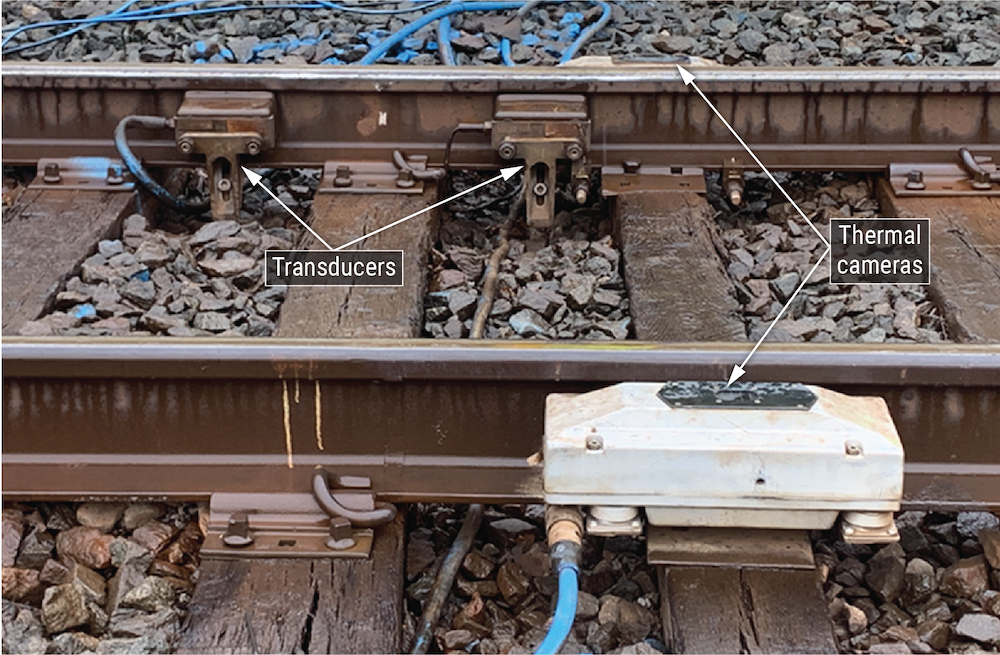WASHINGTON — The 164th car of a Norfolk Southern train triggered a critical hot box detector alert before a May wreck in Pennsylvania, but the train continued on its journey for 15.34 miles before derailing because neither the crew nor the railroad’s network operations center received the warning that would have required the train to stop immediately, the National Transportation Safety Board said in a preliminary report released today.
Signal maintainers working in the area two days before the derailment detached and reattached track-mounted hot box detector components, the NTSB said, but the transducers were attached incorrectly and prompted the detector to report reversed train travel directions.
Data logs don’t show that Norfolk Southern’s advanced train control desk in Atlanta received an alert from the detector, the NTSB said. The advanced train control desk requires an accurate report of train travel direction to interpret hot box detector data. “Under NTSB investigators’ direction, signal maintainers corrected the transducers’ positions. In subsequent tests, NS technicians at the ATC desk in Atlanta confirmed that they had received usable HBD data,” the preliminary report said.

“Post-accident examinations did not identify conditions that would have prevented the HBD from transmitting an alarm message,” the NTSB added. “However, NTSB investigators reviewed the inward-facing image recorder and audio data from the head-end locomotive of train 14M and did not find evidence of an audible alarm being broadcast over the locomotive radio.”
Preliminary results of an examination of the locomotive’s radio showed that it was working, but investigators found a loose coaxial connection between the antenna and radio. NS has sent the radio to its shop in Roanoke, Va., for further analysis.
Merchandise train 14M derailed nine cars in New Castle, Pa., at 10:57 p.m. on May 10, some 38 minutes after it passed the wayside detector at milepost 91.9 on the Youngstown Line, the NTSB said. As part of its investigation, the NTSB recovered burned-off bearing components from the 164th car, which derailed along with cars 165 through 172.
The 671st axle on the train was 253 degrees above the ambient temperature, or 53 degrees above the critical alert threshold that requires the crew to stop and inspect the train, the preliminary report said.
The NTSB said its ongoing investigation will focus on the 164th car’s wheelset and bearing, NS’s use of hot box detectors, and NS railcar inspection practices.
The Conway, Pa., to Buffalo, N.Y., train had one head-end locomotive, 144 loaded cars, 69 empties, and two distributed power units positioned midtrain. The 12,724-foot train weighed 19,993 tons.
The train was traveling at 28 mph at the time of the derailment, or 12 mph below the maximum authorized speed of 40 mph. The derailment included one hazardous material tank car that was carrying paraffin, the NTSB said.
No one was injured in the wreck, which came just over three months after the disastrous Feb. 3 derailment of a Norfolk Southern train in East Palestine, Ohio, after the catastrophic failure of a wheel bearing. A hot box detector sounded an alarm moments before the East Palestine derailment, which released hazardous chemicals and prompted an evacuation.
The East Palestine derailment, along with subsequent wrecks, have put the railroad industry under intense scrutiny from lawmakers, regulators, and media. Federal regulation of wayside detectors is among the regulatory changes being considered in Congress.
“Norfolk Southern continues to cooperate with the NTSB’s investigation and our aim is to learn from what occurred and immediately address any issues that are uncovered,” spokesman Tom Crosson says. “We are always striving to be a better and safer railroad. We have already taken several steps to address how we handle alarms sent by our wayside detectors that monitor for elevated temperatures on railcar wheel bearings and alert crews to a potential bearing failure, which could lead to a derailment.”
NS says it has taken action without waiting for the NTSB preliminary report, including:
- Enhancing technology to provide multiple means of communicating temperature alarms.
- Updated systems processes so that wayside alarms are consistently received by the wayside help desk for investigation regardless of their alignment to a specific train.
- Enhanced standards for locomotive radio trouble reports.
- Strengthened the training of standard operating procedures for employees who install and inspect wayside detectors.
NS on March 6 announced a six-point safety plan to enhance the effectiveness of wayside detectors. And last week the railroad announced both the appointment of an outside consultant to lead an independent review of safety practices and a commitment to partner with labor unions to improve safety.
